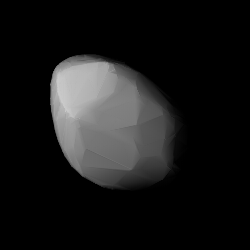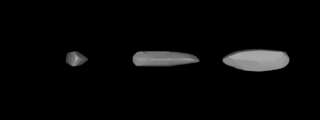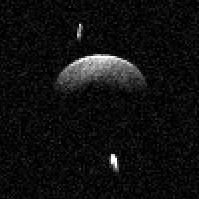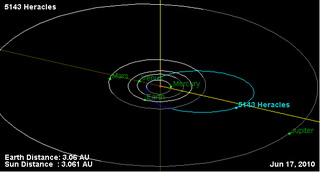Related Research Articles

4183 Cuno, provisional designation 1959 LM, is an eccentric, rare-type asteroid, classified as near-Earth object and potentially hazardous asteroid of the Apollo group, and measures approximately 4 kilometers in diameter.
(52760) 1998 ML14, provisional designation 1998 ML14, is a stony asteroid, classified as near-Earth object of the Apollo group and potentially hazardous asteroid, approximately 1 kilometer in diameter. It was discovered on 24 June 1998, by the LINEAR survey at the Lincoln Laboratory's Experimental Test Site in Socorro, New Mexico.

1685 Toro is an asteroid and near-Earth object of the Apollo group on an eccentric orbit. It was discovered on 17 July 1948, by American astronomer Carl Wirtanen at Lick Observatory on Mount Hamilton, California. The stony S-type asteroid has a rotation period of 10.2 hours and measures approximately 4 kilometers in diameter. It is named for Betulia Toro Herrick, wife of astronomer Samuel Herrick.

2100 Ra-Shalom is an asteroid and near-Earth object of the Aten group on an eccentric orbit in the inner Solar System. It was discovered on 10 September 1978, by American astronomer Eleanor Helin at the Palomar Observatory, California, who named it in commemoration of the Camp David Peace Accords. The C-type asteroid has a rotation period of 19.8 hours and measures approximately 2.7 kilometers in diameter.

1627 Ivar, provisional designation 1929 SH, is an elongated stony asteroid and near-Earth object of the Amor group, approximately 15×6×6 km. It was discovered on 25 September 1929, by Danish astronomer Ejnar Hertzsprung at Leiden Southern Station, annex to the Johannesburg Observatory in South Africa. It was named after Ivar Hertzsprung, brother of the discoverer. 1627 Ivar was the first asteroid to be imaged by radar, in July 1985 by the Arecibo Observatory.
1863 Antinous, provisional designation 1948 EA, is a stony asteroid and near-Earth object, approximately 2–3 kilometers in diameter. It was discovered on 7 March 1948 by American astronomer Carl Wirtanen at Lick Observatory on the summit of Mount Hamilton, California. It was named after Antinous from Greek mythology.

1865 Cerberus is a stony asteroid and near-Earth object of the Apollo group, approximately 1.6 kilometers in diameter. It was discovered on 26 October 1971, by Czech astronomer Luboš Kohoutek at the Hamburger Bergedorf Observatory, Germany, and given the provisional designation 1971 UA. It was named for Cerberus from Greek mythology.

(153591) 2001 SN263 is a carbonaceous trinary asteroid, classified as near-Earth object and former potentially hazardous asteroid of the Amor group, approximately 2.6 kilometers (1.6 miles) in diameter. It was discovered by the Lincoln Near-Earth Asteroid Research project at Lincoln Lab's Experimental Test Site in Socorro, New Mexico, on 20 September 2001. The two synchronous minor-planet moons measure approximately 770 and 430 meters and have an orbital period of 16.46 and 150 hours, respectively.
1943 Anteros, provisional designation 1973 EC, is a spheroidal, rare-type asteroid and near-Earth object of the Amor group, approximately 2 kilometers in diameter.
4957 Brucemurray, provisional designation 1990 XJ, is a stony asteroid, classified as near-Earth object of the Amor group and as Mars-crosser, approximately 3 kilometers in diameter. It was discovered by American astronomer Eleanor Helin at the Palomar Observatory in California on 15 December 1990. The asteroid was named after American planetary scientist Bruce C. Murray.
2363 Cebriones is a large Jupiter trojan from the Trojan camp, approximately 84 kilometers in diameter. It was discovered on 4 October 1977, by astronomers at the Purple Mountain Observatory in Nanking, China. The dark D-type asteroid is one of the 40 largest Jupiter trojans and has a rotation period of 20 hours. It was named after Cebriones, Hektor's charioteer from Greek mythology.

5143 Heracles, provisional designation 1991 VL, is a highly eccentric, rare-type asteroid and synchronous binary system, classified as near-Earth object of the Apollo group, approximately 4.8 kilometers in diameter. The asteroid was discovered on 7 November 1991, by American astronomer Carolyn Shoemaker at Palomar Observatory in California, United States. It is named for the Greek divine hero Heracles. It has an Earth minimum orbit intersection distance of 0.058 AU (8.7 million km) and is associated with the Beta Taurids daytime meteor shower.
4055 Magellan, provisional designation 1985 DO2, is a bright and eccentric asteroid and near-Earth object of the Amor group, approximately 2.5 kilometers in diameter. It was discovered on 24 February 1985, by American astronomer Eleanor Helin at Palomar Observatory in California, United States. It was later named for Portuguese explorer Ferdinand Magellan.
2895 Memnon is a dark Jupiter trojan from the Trojan camp, approximately 56 kilometers in diameter. It was discovered on 10 January 1981, by American astronomer Norman Thomas at Lowell's Anderson Mesa Station near Flagstaff, Arizona, in the United States. The assumed C-type asteroid has a rotation period of 7.5 hours and belongs to the 80 largest Jupiter trojans. It was named after King Memnon from Greek mythology.

1980 Tezcatlipoca, provisional designation 1950 LA, is an eccentric, stony asteroid and near-Earth object of the Amor group, approximately 6 kilometers (4 mi) in diameter.

4715 Medesicaste (prov. designation: 1989 TS1) is a dark Jupiter trojan from the Trojan camp, approximately 64 kilometers (40 miles) in diameter. It was discovered on 9 October 1989, by Japanese astronomer Yoshiaki Oshima at the Gekko Observatory east of Shizuoka, Japan. The assumed C-type asteroid belongs to the 70 largest Jupiter trojans. It is possibly elongated in shape and has a rotation period of 8.8 hours. It was named from Greek mythology after Medesicaste, an illegitimate daughter of Trojan King Priam.
(5646) 1990 TR is a probable rare-type binary asteroid classified as near-Earth object of the Amor group, approximately 2.3 kilometers in diameter. It was discovered on 11 October 1990, by Japanese astronomers Seiji Ueda and Hiroshi Kaneda at Kushiro Observatory near Kushiro, in eastern Hokkaido, Japan.
(10115) 1992 SK, is a stony near-Earth object and potentially hazardous asteroid on an eccentric orbit. It belongs to the group of Apollo asteroids and measures approximately 1 kilometer in diameter. It was discovered by American astronomers Eleanor Helin and Jeff Alu at the Palomar Observatory in California on 24 September 1992.
21088 Chelyabinsk, provisional designation 1992 BL2, is a stony asteroid and near-Earth object of the Amor group, approximately 4 kilometers in diameter. It was discovered on 30 January 1992, by Belgian astronomer Eric Elst at ESO's La Silla Observatory in northern Chile. The asteroid was named after the Russian city of Chelyabinsk and for its spectacular Chelyabinsk meteor event in 2013.
(385343) 2002 LV, provisional designation 2002 LV, is a stony asteroid on a highly eccentric orbit, classified as near-Earth object and potentially hazardous asteroid of the Apollo group, approximately 1.5 kilometers in diameter. It was discovered on 1 June 2002, by astronomers with the Lincoln Near-Earth Asteroid Research at the Lincoln Laboratory's Experimental Test Site near Socorro, New Mexico, in the United States. The Sr-type asteroid has a rotation period of 6.2 hours and is likely elongated.
References
- 1 2 3 4 5 6 7 "143651 (2003 QO104)". Minor Planet Center. Retrieved 20 April 2018.
- 1 2 3 4 5 6 "JPL Small-Body Database Browser: 143651 (2003 QO104)" (2018-01-26 last obs.). Jet Propulsion Laboratory . Retrieved 20 April 2018.
- 1 2 3 4 5 6 "LCDB Data for (143651)". Asteroid Lightcurve Database (LCDB). Retrieved 20 April 2018.
- 1 2 3 Mueller, Michael; Delbo', M.; Hora, J. L.; Trilling, D. E.; Bhattacharya, B.; Bottke, W. F.; et al. (April 2011). "ExploreNEOs. III. Physical Characterization of 65 Potential Spacecraft Target Asteroids". The Astronomical Journal. 141 (4): 9. Bibcode:2011AJ....141..109M. doi: 10.1088/0004-6256/141/4/109 . S2CID 44827674.
- 1 2 3 4 Trilling, D. E.; Mueller, M.; Hora, J. L.; Harris, A. W.; Bhattacharya, B.; Bottke, W. F.; et al. (September 2010). "ExploreNEOs. I. Description and First Results from the Warm Spitzer Near-Earth Object Survey" (PDF). The Astronomical Journal. 140 (3): 770–784. Bibcode:2010AJ....140..770T. doi:10.1088/0004-6256/140/3/770. S2CID 3006566.
- 1 2 Birtwhistle, Peter (October 2009). "Lightcurves for Five Close Approach Asteroids". The Minor Planet Bulletin. 36 (4): 186–187. Bibcode:2009MPBu...36..186B. ISSN 1052-8091.
- 1 2 3 Koehn, Bruce W.; Bowell, Edward G.; Skiff, Brian A.; Sanborn, Jason J.; McLelland, Kyle P.; Pravec, Petr; et al. (October 2014). "Lowell Observatory Near-Earth Asteroid Photometric Survey (NEAPS) - 2009 January through 2009 June". The Minor Planet Bulletin. 41 (4): 286–300. Bibcode:2014MPBu...41..286K. ISSN 1052-8091.
- 1 2 3 4 5 Warner, Brian D.; Stephens, Robert D.; Carbognani, Albino (October 2009). "Analysis of the Slow Rotator (143651) 2003 QO104". The Minor Planet Bulletin. 36 (4): 179–180. Bibcode:2009MPBu...36..179W. ISSN 1052-8091.
- 1 2 Thomas, C. A.; Trilling, D. E.; Emery, J. P.; Mueller, M.; Hora, J. L.; Benner, L. A. M.; et al. (September 2011). "ExploreNEOs. V. Average Albedo by Taxonomic Complex in the Near-Earth Asteroid Population". The Astronomical Journal. 142 (3): 12. Bibcode:2011AJ....142...85T. doi: 10.1088/0004-6256/142/3/85 .
- 1 2 Thomas, Cristina A.; Emery, Joshua P.; Trilling, David E.; Delbó, Marco; Hora, Joseph L.; Mueller, Michael (January 2014). "Physical characterization of Warm Spitzer-observed near-Earth objects". Icarus. 228: 217–246. arXiv: 1310.2000 . Bibcode:2014Icar..228..217T. doi:10.1016/j.icarus.2013.10.004. S2CID 119278697.
- 1 2 3 Ye, Q.-z. (February 2011). "BVRI Photometry of 53 Unusual Asteroids". The Astronomical Journal. 141 (2): 8. arXiv: 1011.0133 . Bibcode:2011AJ....141...32Y. doi:10.1088/0004-6256/141/2/32. S2CID 119307210.
- 1 2 Betzler, Alberto S.; Noaves, Alberto B.; Santos, Antonio C. P.; Sobral, Edvaldo G. (July 2010). "Photometric Observations of the Near-Earth Asteroids 1999 AP10 2000 TO64, 2000 UJ1, 2000 XK44, 2001 MZ7, 2003 QO104, 2005 RQ6, 2005 WJ56, and 2009 UN3". The Minor Planet Bulletin. 37 (3): 95–97. Bibcode:2010MPBu...37...95B. ISSN 1052-8091.
- ↑ Veres, Peter; Jedicke, Robert; Fitzsimmons, Alan; Denneau, Larry; Granvik, Mikael; Bolin, Bryce; et al. (November 2015). "Absolute magnitudes and slope parameters for 250,000 asteroids observed by Pan-STARRS PS1 - Preliminary results". Icarus. 261: 34–47. arXiv: 1506.00762 . Bibcode:2015Icar..261...34V. doi:10.1016/j.icarus.2015.08.007. S2CID 53493339.
- ↑ "List of the Potentially Hazardous Asteroids (PHAs)". Minor Planet Center. Retrieved 20 April 2018.
- ↑ "Major News about Minor Objects (2003 QO104)". hohmanntransfer. 27 December 2003. Retrieved 20 April 2018.
- ↑ "NEOs Removed from Impact Risks Tables". Near Earth Object Program. NASA. Archived from the original on 2 June 2002. Retrieved 20 April 2018.
- 1 2 "JPL Small-Body Database Browser: 143651 (2003 QO104)". Jet Propulsion Laboratory. Retrieved 20 April 2018.
- ↑ "MPC/MPO/MPS Archive". Minor Planet Center. Retrieved 20 April 2018.